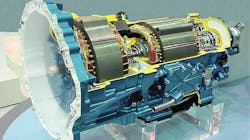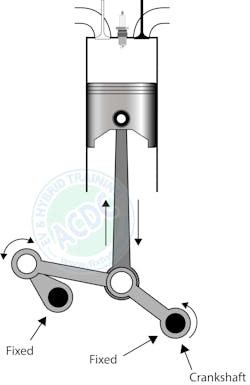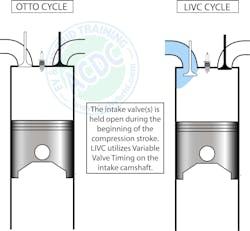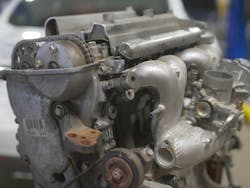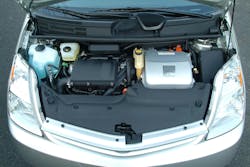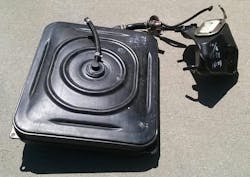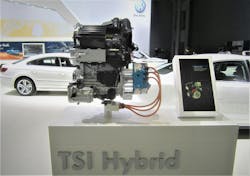The reason why hybrids were first introduced to America in 1999 had everything to do with the internal combustion engine (ICE). Well, not the ICE itself, but the gasoline we put in the tank. Using hybrid technology 25 years ago we could have doubled the average fuel mileage so we would have more time to solve the climate problem. We did not do that. Carbon neutral liquid fuels can be made, but at a high cost. If we did that, then the ICE would be something we could live with, but that is not feasible. The cost to produce close to zero carbon fuel is high. It also might impact the amount of food crops we eat, so other ideas have been developed. To get to an “Almost Zero Carbon” world, we must find other ways to travel. In terms of light duty transportation, the hybrid was the answer a couple decades ago and the internal combustion engine was part of that research.
Here are some examples of internal combustion engines sold in the USA. What made them burn less fuel and still have the power needed to propel a car? In other words, how did a little gasoline engine act like a much larger engine?
James Atkinson invented a new type of gasoline engine in 1880s, commonly known as an “Atkinson Cycle." (Figure 1). It used valves, a camshaft and a connecting rod that changed lengths to produce four piston strokes for every one revolution of the crankshaft. Check online for this and watch the piston move at different speeds during its rotation. The intake and compression strokes were significantly shorter than the expansion and exhaust strokes. These odd engines were produced and sold for several years by the British Engine Company over a century ago. James Atkinson also licensed production to other manufacturers, but this type of engine never caught on. Today, that exact ICE design is used by Honda in a generator called “Free Watt.” Because of Honda, a real “Atkinson Cycle” engine does exist today. If an actual Atkinson Cycle engine were to be used in a modern car, the crankshaft would not survive the repeated RPM changes and stress of shifting. The Honda “Free Watt” engine (Figure 2) operates at one speed and is a 166 cc, single cylinder that runs on natural gas. The little Honda engine is used as a generator for homes and also heats the house and provides hot water.
LIVC
Contrary to what you may have seen or heard, a real “Atkinson Cycle” engine is not used in any motor vehicle sold today. LIVC stands for "Late Intake Valve Closing." It is the valve train and induction system that mimics, to some degree, what the Atkinson system was doing. LIVC is used in many, but not all, hybrid and plug-in hybrid models. LIVC is also used in some conventional cars and trucks. We will use “LIVC” and not “Atkinson Cycle” when referring to these gasoline engines.
When Toyota was creating the Prius in the early 1990s, they had one big advantage that allowed them to develop a new concept based on the old “Atkinson Cycle” engine. Toyota had designed all their transmissions with a powerful electric motor (M/G2) inside the transmission (Figure 3) that combined with their “LIVC” ICE, powered the wheels with lots of low end torque.
How Toyota employed LIVC is simple in operation. It is always a twin cam engine as it needs to vary the intake valve(s) timing. When used in Toyota/Lexus vehicles the timing of the opening and closing of the intake valves is controlled by the Toyota-designed VVT-i system. During the compression stroke, the intake valve is held open. (Figure 4) Compression does not happen until the intake valve(s) closes. While the intake valve is open during the compression event, the mixture is pushed back into the intake manifold. You will note that the intake manifold has a chamber, or bellows, (Figure 5) formed into the manifold allowing a space for the mixture to collect. At some point in the compression stroke the intake valve(s) will eventually close and then the mixture will start to compress. During this compression stroke some of the mixture moves into the intake manifold to reduce pumping losses. Pumping losses represent the power lost when the engine rotates during periods of high vacuum. LIVC changes the volume, or displacement, of the cylinder and also supplies a charge of fuel and air for the next cylinder in the firing order.
These engines have a high compression ratio number but operate at a low compression ratio most of the time. They also perform best with low-octane fuel, something that is not characteristic of high-compression engines. The LIVC engine allows for a more efficient operation, but sacrifices were made in the total output of the engine. The ICE can run with normal displacement when the intake valves close earlier, but this is not needed at cruising speed. This action provides for more power output but at a cost. Because the VVT-i system responds to operating conditions, the displacement of the engine changes accordingly. The VVT-i system is managed by the PCM, and with that control, the intake valves can change quickly (within a range of 40 degrees or more) depending on the model. The PCM adjusts valve timing according to engine speed, intake air volume, throttle position, load, and water temperature. In response to these inputs, the PCM sends commands to the camshaft timing oil control valve (OCV). The VVT-i controller is located at the end of the intake camshaft, like most systems. The PCM controls the oil pressure sent to the controller. A change in oil pressure changes the position of the intake camshaft and the timing of the intake valves. The camshaft timing OCV is duty cycled by the PCM to advance or retard intake valve timing.
An aerodynamic vehicle with low weight and low-friction-producing components will get you further on the same amount of liquid fuel. In addition to controlling the VVT-i system, the vehicle’s PCM also controls the fuel injection timing and the ignition system. Inputs from numerous sensors are used to optimize the ICE in order to provide maximum fuel economy. Starting in M/Y 2004 the Prius used an air/fuel sensor rather than a conventional oxygen sensor. The ETCS-i (Electronic Throttle Control System with intelligence) system controls the position of the throttle plate. There is no cable between the accelerator pedal and the throttle plate. The eCVT (electronically controlled constantly variable transmission) requires precise control of the planet carrier inside the planetary gear set. More about this will be explained when you study a Toyota eCVT. If the throttle on a Toyota (or Ford, as they use a similar system) hybrid cannot be perfectly controlled, serious transmission damage will result. The PCM calculates the proper throttle opening and sends, via a CAN bus, the signals needed to open and close the throttle plate.
The Prius gasoline engine (Figure 6) was 1.5 liters from M/Y 1998 to 2009. In M/Y 2010 a 1.8L was installed. Even though the displacement increased, so did advancements in fuel economy, performance, and exhaust emissions. One note here: the 1.5L has a tendency to burn oil at 150,000 miles even if the oil changes were done on a reasonable time frame. Today, many car owners do not get oil changes on time, and sometimes use poor quality oil. Trying to save money, the engine suffers. To counter these problems, most independent hybrid repair shops use a de-carboning system to dissolve the carbon on the piston rings that tend to be the reason for the oil consumption.
Strange Gas Tank
The country we live in has very strict regulations in regards to gasoline evaporating into our atmosphere. Japan is not as concerned, so Toyota needed new technology in that area as the ICE did not run all the time while the Prius was in motion. To accomplish that, the fuel was stored in a flexible plastic/rubber compound called a “bladder”, having a similar function as a human bladder. Toyota added this bladder in the steel fuel tank of the Prius generation I and II (M/Y 2001 to 2009). (Figure 7) From the outside it looks like a typical gas tank. It is sold as one unit. The engine and 02 sensor test the air gap between the bladder and steel tank. It is looking for the presence of HC in the air sample from between the bladder and tank indicating an internal fuel leak. The best way to know what is going on is to use an enhanced scan tool looking at data and codes.
Tech tip: if you get a code for a leaking bladder, before replacing the gas tank, make sure the owner does not have the habit of “topping off” when refueling. If they do, gasoline can get between the tank and the bladder, causing that code. Fix the customer or the job will come back. It is no secret that Toyota has had problems with first generation bladder tanks.
VW Jetta HEV
The ICE in the M/Y 2013 Jetta HEV is a 1.4-liter direct injection turbocharged four cylinder. (Figure 8) It is attached to a seven-speed dual-clutch transmission with a 20-hp electric motor installed between the ICE and transmission. Total system output is 170 hp (125 kW) and 184 lb-ft (250 Nm) of torque, the latter available from only 1,000 rpm. Considering that the Jetta Hybrid requires premium gasoline, the fuel mileage is important as it costs more for fuel than most other HEVs. The Jetta Hybrid is equipped with a TSI “turbocharged stratified injection” engine with a single turbocharger.
To make this ICE ready for hybrid duty, VW modified the engine block with an integrated secondary air channel, hybrid oil passages and hybrid coolant passages. The crankshaft needed splines for connection to the HV electric motor and the cylinder head used four valves per cylinder. It had an integrated exhaust manifold. That exhaust trick was done by Honda in the original Insight back in 2000. The intake and exhaust camshaft had adjustable timing and they were belt-driven. VW had both electrical and mechanical coolant pumps. The positive crankcase ventilation (PCV) system is on the front of the engine block. The intercooler is liquid-cooled. When vacuum is needed, and the ICE is off, VW added an electric vacuum pump.
VW Turbo Boost
Because the VW 1.4 engine performance is good without the turbo and using “boost” contributes to fuel consumption, the use of the boost is limited. It will not boost if the kick-down position of the accelerator pedal is activated in position “D”, or when there is strong acceleration at selector lever position “S” and also when the “Tiptronic” shift gate is engaged.
A Mode Without Turbo
The HV electric motor is adding torque to the drivetrain, along with ICE, and the total torque from both may reach a “maximum torque” that the Dual Clutch Transmission (DCT) was not designed for. The Jetta HEV will disengage the Turbo if the DCT could be damaged. There have been software updates and transmission problems associated with this model.
Conclusion
The evolution of gasoline engines has been going on in the hybrid world for over 25 years. When changing oil, pay attention to the “Fill” line on the dipstick. Many technicians will guess about the amount of oil. I often ask in class, how many quarts equals 3.5 liters? The answer is not four quarts. It is 3.7 quarts. That 0.3 quarts overfilled is a problem for a LIVC engine. As you study more about hybrids, don’t forget many have a unique engine. As always, use quality lubricants, deionized antifreeze, OEM equivalent parts, and use service information. The little things matter. I want to thank all of the automotive technicians that have supported ACDC since our first hybrid class 25 years ago when Honda shipped me an Insight from Japan.
